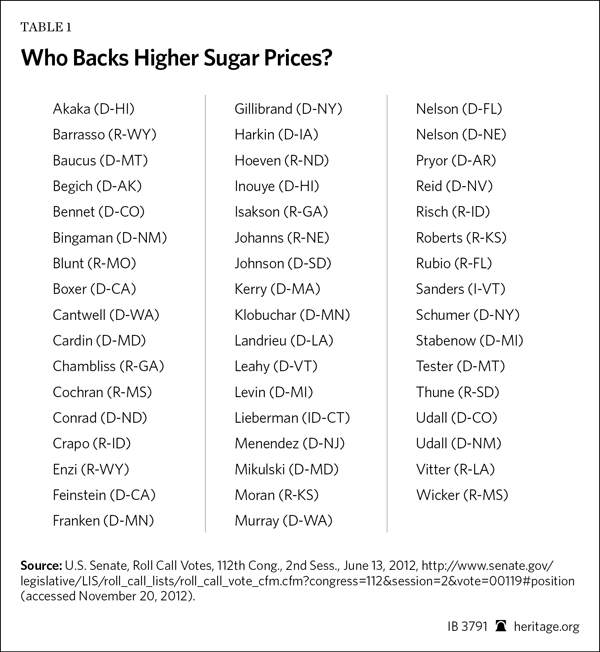Lobbyists for sugar growers—already forced to rely on shady arguments to persuade Congress to keep giving handouts to their clients—are facing a new P.R. problem: Twinkie production may be moving to Mexico. Hostess, the maker of Twinkies, has blamed union troubles for its bankruptcy, but other experts have pointed to U.S. government-inflated sugar prices as a possible factor in the company’s decline.[1]
Government interference in the sugar market hurts consumers and food manufacturers by driving up the price of sugar, reducing export opportunities by giving other countries an excuse to impose similar penalties on U.S.-made products, and weakening the U.S. economy. This Depression-era program, which was supposed to end in 1940, should be abolished.[2]
Sugar Industry Lobbyists: A War on “Big Candy”
Ironically, Hostess announced it was closing its doors just one week after the American Sugar Alliance (ASA), which supports the costly U.S. sugar program, said big U.S. sugar users are not hurt by the sugar program. Referring to a recent drop in sugar prices, the Sugar Alliance appealed for continued protectionism:
“Big Candy says it needs rock bottom prices with surpluses as far as the eye can see, and it has spent millions of dollars lobbying Congress with the message that the no-cost U.S. sugar policy stands in the way of that goal. Now that their wish has come true, perhaps they can acknowledge that current U.S. policy is not the bogeyman they pretend and can stop lobbying to put U.S. farmers out of business,” said Phillip Hayes, spokesperson for the American Sugar Alliance. “U.S. sugar producers desperately need Congress to renew no-cost sugar policy if they are going to have a chance to survive.”[3]
Use of the expression “no-cost U.S. sugar policy” is no innocent mistake. So far this year, 27 of the 35 Sugar Alliance press releases repeat this language. However, the deceptive phrase “no-cost U.S. sugar policy” is an outrageous misrepresentation of the truth.
According to the U.S. Department of Agriculture’s Economic Research Service, “U.S. sugar prices have been well above world prices since 1982 because the U.S. Government supports domestic sugar prices through loans to sugar processors and a marketing allotment program.”[4]
The U.S. government artificially inflates sugar prices to help sugar growers by imposing quotas that restrict the amount food manufacturers and consumers in the United States can buy from producers in other countries. If a bakery or a candy company wants to import more sugar than is allowed under the government’s quota, it must pay a prohibitive tariff of 15.36 cents per pound for raw sugar.
In October, sugar cost 52.54 cents per pound in the United States and 44.78 cents per pound in other countries.[5] The difference between 52.54 cents and 44.78 cents is not “zero.”
In October, people in the United States paid 7.76 cents per pound extra for sugar, but the “no-cost” sugar program usually costs Americans even more. Over the past 12 months, Americans paid a big surcharge for sugar. The average price of sugar in the United States was 68.95 cents per pound, 41 percent above the world market price.
This is a no-cost program?
In fact, since President Obama took office, prices for sugar and sweets have increased by 8.9 percent.[6]
Sugar Industry Lobbyists vs. Freedom
Sugar lobbyists have attempted to present a false choice between sugar farmers and “big candy.” However, the real choice is between freedom and big government: Should Congress be able to override Americans’ freedom of choice by dictating the price of sugar based on which industries have the most political clout?
Sugar represents less than 2 percent of the value of all U.S. crop production, but in 2012 sugar lobbyists have accounted for more than one-third of all crop-industry lobbying expenditures. Sugar producers reported $5.4 million in 2012 lobbying expenses, compared to $10 million for all other crops.[7] In the 2012 election cycle, sugar industry Political Action Committees (PACs) donated $3.4 million to candidates, which is more than the combined $3.3 million spent by PACS for wheat, soybeans, and all other crops.[8]
What to Do Next
The Senate nearly killed the sugar program earlier this year by a 50-46 vote. Only 50 Senators backed the program—32 Democrats, 16 Republicans, and two Independents—which inched the sugar program closer to its long-overdue demise.

There are several reasons to end the sugar program, including the prospect of Mexican-made Twinkies, as food manufacturers continue to relocate to countries where sugar is affordable. However, the most important reason Congress should end the sugar program is to demonstrate that Americans’ freedom is more important than the profits of any particular special interest group.
Twinkies Never Die, But Sugar Subsidies Should
Eventually, Americans will be able to buy Hostess products again, whether they are produced in the United States or Mexico. In the meantime, people who crave Twinkies can drive north to Canada to satisfy their desires. In Canada, where tariffs on imported sugar are insignificant, the country’s largest snack-cake manufacturer will continue to crank out Hostess Twinkies and CupCakes.[9]
—Bryan Riley is Jay Van Andel Senior Analyst in Trade Policy in the Center for International Trade and Economics at The Heritage Foundation.


